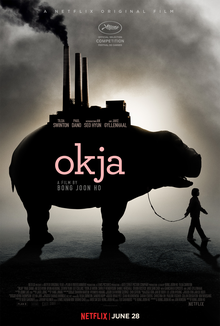
The adorable animal that is threatened by big business only to be saved by its loving family is a genre in itself and not one that is particularly appealing to me. They are basically children’s films. Still, Boon Joon-ho has a track record that is good enough to give him the benefit of the doubt and I rather like the idea of watching more Hollywood stars working under his direction.
The new head of the agri-industrial corporation Mirando, Lucy Mirando, announces a plan to promote their new line of genetically engineered giant pigs. Specimens are dispatched around the world to be raised by local farmers and the best one will win the global competition. Ten years later, Okja, bred in South Korea and raised by a young girl named Mija is chosen by the popular zoologist Johnny Wilcox to be the winner. Mija at first does not quite realize that Okja is to be separated from her and when she does so chases him to Seoul. There she runs into members of the Animal Liberation Front, an activist group who wants to discredit the Mirando Corporation. After a chaotic chase, they explain to her that the super pigs are meant to become food animals for humans and allow Okja to be recaptured after putting an electronic bug on her. Lucy Mirando tries to put a good spin to the fracas by bringing both Mija and Okja to New York. Naturally the ALF crashes this event to bring the truth about the horrific conditions under which the animals are bred to the world.
The plot unfolds almost exactly according to the standard formula and the film pushes its environmentalist and vegan messaging for all its worth. Yet for all its predictability, there are one or two surprises but the jury’s out on whether they’re good ones. One example is the extreme tonal shifts that the film undergoes. On the one hand there’s a playful silliness to it, exemplified by the over the top figure of Wilcox and how it uses Okja’s feces as a recurring gag. This is exactly the sort of thing that you would expect in a children’s film. At the same time this is also a film that contains a no-holds-barred walkthrough of an abbatoir with graphic scenes of every step of the process that turns a large, live animals into tiny pieces of jerky. Less graphic but no less horrifying is Wilcox’s nervous breakdown on the blood smeared floor of the slaughterhouse. These scenes are tough for adults to watch, nevermind children, and it really makes me wonder what the director was thinking in allowing such a wild swing from one extreme to another.
Similarly the rest of the film is an eclectic mix of unusually reasonable arguments and wildly unrealistic assumptions. I like that there is no miraculous happy ending for the super pigs and Okja’s own inevitable salvation comes down to surrendering to the realities of capitalism. It’s also interesting that while the ALF is predictably opposed to genetically modified organisms and the film as a whole is sympathetic to their cause, it never actually offers any pseudo-scientific arguments to support that position. In fact, it depicts Mirando’s executives as being so confident in the safety of their product that they happily munch it and everyone who tastes it comments on how good it is. At the same time, the biological foundations of Okja’s species don’t make any sense. The amount of food that a creature of that size and that level of physical activity it is capable of must be truly prodigious and I laugh at the thought of the traditional farmer raising such an animal by foraging on food sources that he doesn’t own. Plus how economic is it to have to raise a live animal for ten years before it is marketable?
All in all, this is a very strange mixed bag of all kinds of components that don’t really fit together very well. The philosophical question at the heart of the film isn’t serious because given the demonstrated mental acuity of Okja, the activists should be attempting to prove that the species is sapient. Instead whatever grounds for opposing them being raised for food purposes lies entirely on the fact that they are adorable and can form strong emotional bonds with people. Ironically while the scenes abattoir is intended to be chilling, and they are, they also seem like a fairly honest portrayal. If we must consume meat animals, the methods portrayed here seem to be the most humane, painless and professional way to do it. The film does serve as a useful reminder that all meat consumption is based around killing animals but I think that inserting a fantasy giant animal to tell that story rather muddies the message.